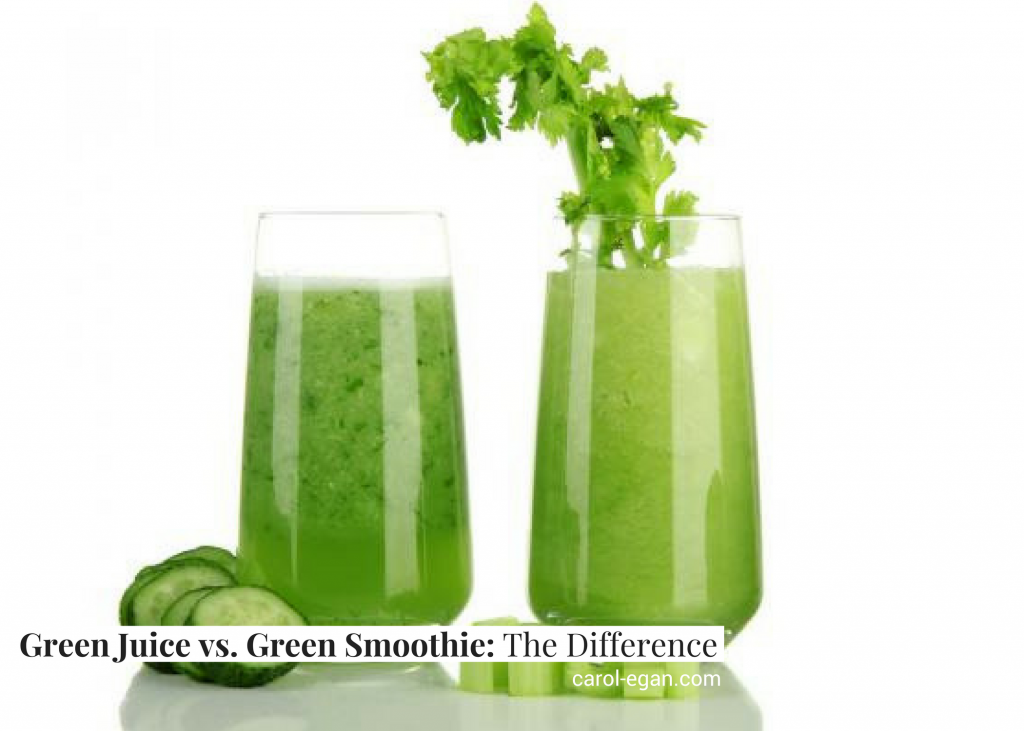 Green juice and green smoothies are taking the world by storm today. With the spotlight on the nutritional benefits of kale, spinach and other leafy greens, interest in green drinks continue to grow, as does the demand in local juice and smoothie bars.
Green juice and green smoothies are taking the world by storm today. With the spotlight on the nutritional benefits of kale, spinach and other leafy greens, interest in green drinks continue to grow, as does the demand in local juice and smoothie bars.
But many ask, what’s the difference between a green juice and a green smoothie? Isn’t it better to leave the fiber in the fruits and vegetables? Which one is better for you?
While there is much debate about this, with varying opinions as to which is better for you, a juice or a smoothie, both offer benefits, albeit very different benefits. Let me explain.
Smoothies are made by processing whole fruits and vegetables in a blender, so they retain the fiber of all ingredients. Because smoothies retain the fiber, they tend to be more satiating than green juice. Green smoothies are quick to make, can be loaded up with ingredients like avocado, sprouts and raw cacao for a chocolatey flavor… and are a great stand in for any meal or snack.
Because of the delicious combinations possible, smoothies are a great springboard to healthier eating habits for newcomers.
However, when making green smoothies, do note:
- The blending process breaks the fiber down in a smoothie, but you still need to chew it to activate the digestive enzyme in saliva, amylase. Amylase begins the digestive process.
- Choose combinations like leafy greens with less starchy fruits like berries, green apples, pears, peaches and plums to ensure healthy digestion, healthy elimination and reduce the risk of fermentation or gas.
- Use only fresh produce. Disregard recipes that suggest using frozen kale, for example. Fresh fruits and vegetables deliver the live, vital, electricity your cells need to activate!
- A smoothie cannot take the place of green juice.
Green juice is made by extracting the vegetable and fruit water from the whole foods used, and discarding the fiber, unlike with smoothies.
This is what many do not understand. They ask, why would you separate the fiber from the water in the vegetables and throw it away?
In a nutshell, when you drink juice, no digestive fire is required. Your digestive system doesn’t have to do anything to take in the nutrients provided from the foods you juiced.
Think of it this way, juice is like an IV running medicine into your body, with the vitamins, minerals, phytonutrients and live energy from the fresh fruits and vegetables going directly to your cells to nourish and regenerate.
But also think of green juice this way, because it’s so electrically charged, green juices act like a magnet in the body and pull toxic waste matter out of the tissues and cells.
This is especially helpful for all of us who have lived on some version of the Standard American Diet, and suffer from any acute or chronic condition, excess weight, low energy or premature aging because you can take in so much more nutrition when you drink it, versus eating it. If our ability to absorb or assimilate is impaired in any way, green juice bypasses that and gets the nutrients right to the cells.
Green juice offers the most easily accessible and assimilable form of live, vital nutrition. But do consider this, juice is concentrated because fiber was removed, so you want to limit sweet fruits, or it will blast your system with sugar. Sweet fruits are best in smoothies, rather than juices.
My first recommendation always is green juice, but even with their differences, green juices and green smoothies are an awesome and healthy answer to the Standard American Diet laden with processed and nutrient-devoid foods.
Want to experience what more green in your diet feels like? Want to deep dive into an anti-inflammatory, get-healthy game to get your warm-weather swagger on? Join me this Spring for one of my favorite little programs, More Than A Detox. You can learn more about it here.





